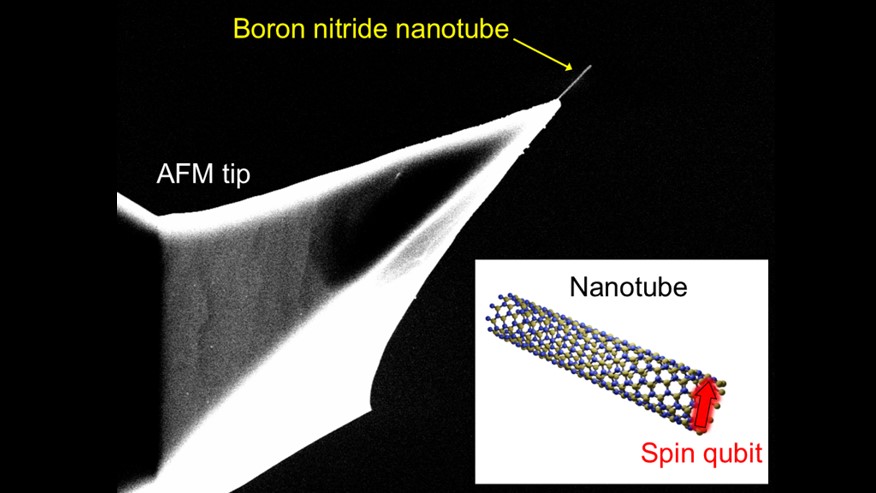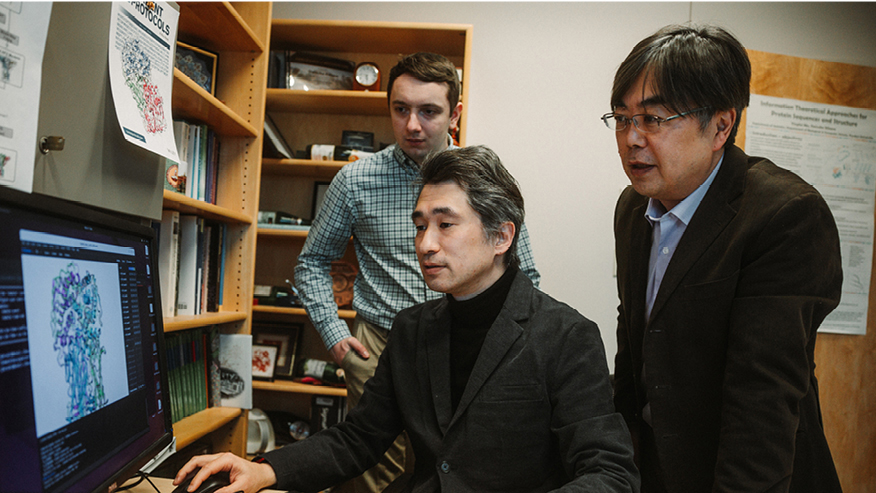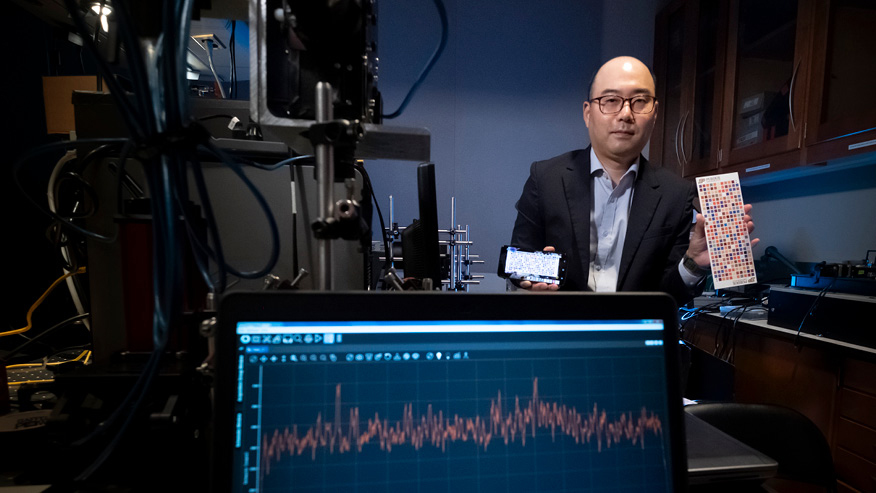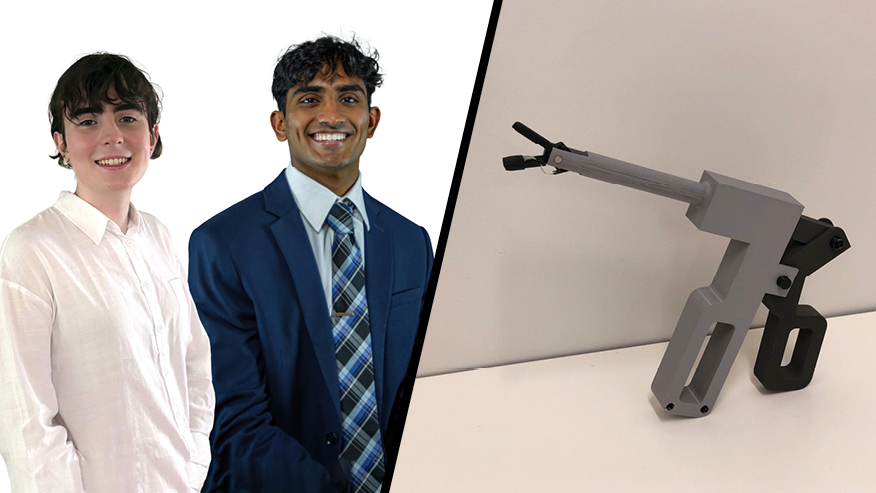Purdue researchers create orientation-independent magnetic field-sensing nanotube spin qubits
Research published in Nature Communications

A scanning electron microscope image shows an atomic force microscope tip with a boron nitride nanotube containing a spin qubit. Purdue researchers have developed the technology, which detects off-axis magnetic fields at high resolution better than traditional diamond tips. (Purdue University image/Tongcang Li)
WEST LAFAYETTE, Ind. — Purdue University researchers have developed patent-pending one-dimensional boron nitride nanotubes (BNNTs) containing spin qubits, or spin defects. The BNNTs are more sensitive in detecting off-axis magnetic fields at high resolution than traditional diamond tips used in scanning probe magnetic-field microscopes.
Tongcang Li, a professor of physics and electrical and computer engineering, leads a team that has developed the BNNTs with optically active spin qubits. He also is on the faculty of the Purdue Quantum Science and Engineering Institute. The team includes Xingyu Gao, Sumukh Vaidya and Saakshi Dikshit, graduate students at Purdue who are co-authors of a paper published in the peer-reviewed journal Nature Communications.
“BNNT spin qubits are more sensitive to detecting off-axis magnetic fields than a diamond nitrogen-vacancy center, which is primarily sensitive to fields that are parallel to its axis, but not perpendicular,” Li said. “BNNTs also are more cost-effective and offer more resilience than brittle diamond tips.”
BNNT applications include quantum-sensing technology that measures changes in magnetic fields and collects and analyzes data at the atomic level.
“They also have applications in the semiconductor industry and nanoscale MRI, or magnetic resonance imaging,” Gao said.
Li disclosed the nanotube spin qubits to the Purdue Innovates Office of Technology Commercialization, which has applied for patents to protect the intellectual property. Industry partners interested in developing or commercializing them should contact Parag Vasekar, business development and licensing manager, physical sciences, at psvasekar@prf.org, about track code 70437.
Testing and developing BNNT spin qubits
The system was tested on a custom-built laboratory system, including lasers, detectors and signal generators for controlling the quantum state of the nanotube spin qubits.
“These BNNT spin qubits are sensitive to magnetic fields and exhibit optically detected magnetic resonance,” Vaidya said. “When exposed to a magnetic field, the energy levels of the spin qubits within the BNNTs are altered, which can be measured using light.”
On the first demonstration, BNNTs performed comparably to diamond tips.
“Since the boron nitride nanotubes are spatially much smaller than the diamond tips, we expect to be able to achieve superior numbers for the system,” Dikshit said.

Li said the Purdue researchers are looking to improve the spatial resolution and magnetic field sensitivity for the BNNT spin qubit system. These improvements could enable quantum sensing of phenomena at the atomic scale.
“This would enable a very high-resolution scanning of the surface magnetic properties,” Vaidya said. “By improving the sensitivity, we can either get more precise information or achieve faster readout of the external magnetic fields, both of which have applications in quantum science, memory storage, medical and semiconductor industries.”
The Gordon and Betty Moore Foundation and the National Science Foundation provided funding to Li and his team to conduct this research.
About Purdue Innovates Office of Technology Commercialization
The Purdue Innovates Office of Technology Commercialization operates one of the most comprehensive technology transfer programs among leading research universities in the U.S. Services provided by this office support the economic development initiatives of Purdue University and benefit the university’s academic activities through commercializing, licensing and protecting Purdue intellectual property. In fiscal year 2024, the office reported 145 deals finalized with 224 technologies signed, 466 invention disclosures received, and 290 U.S. and international patents received. The office is managed by the Purdue Research Foundation, a private, nonprofit foundation created to advance the mission of Purdue University. Contact otcip@prf.org for more information.
About Purdue University
Purdue University is a public research institution demonstrating excellence at scale. Ranked among top 10 public universities and with two colleges in the top four in the United States, Purdue discovers and disseminates knowledge with a quality and at a scale second to none. More than 105,000 students study at Purdue across modalities and locations, including nearly 50,000 in person on the West Lafayette campus. Committed to affordability and accessibility, Purdue’s main campus has frozen tuition 13 years in a row. See how Purdue never stops in the persistent pursuit of the next giant leap — including its first comprehensive urban campus in Indianapolis, the Mitch Daniels School of Business, Purdue Computes and the One Health initiative — at https://www.purdue.edu/president/strategic-initiatives.
Media contact: Steve Martin, sgmartin@prf.org



